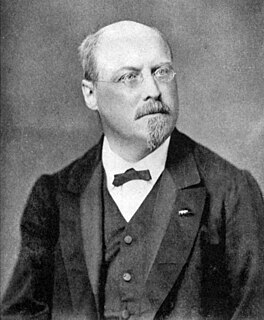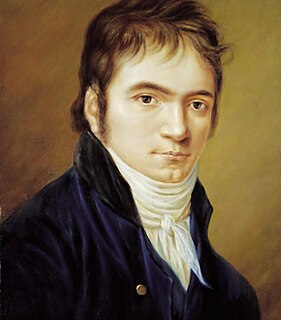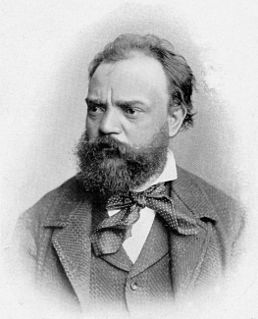Scoring and structure
The symphony is scored for 2 flutes, 2 oboes, 2 clarinets in A, 2 bassoons, 4 horns in F, 2 trumpets in F, 2 trombones, bass trombone, timpani and strings.
The symphony is structured in five movements:
- Allegro
- Scherzo. Allegro molto vivace (D minor)
- Larghetto (B-flat major)
- Allegro dramatico (G minor)
- Larghetto sostenuto (D minor)
Raff uses extensively a melody composed in 1825 by Gustav Reichardt for Ernst Moritz Arndt's poem Was ist des Deutschen Vaterland? . [1]
According to Helen Raff's biography of her father, "The first three movements are supposed to show German life and existence, the fourth describes German disunity." She further adds: "The fifth movement begins with a lament on the destiny of greater Germany and then proceeds to develop prophetic visions of future unity and majesty." Joachim Raff's note about the symphony states "Here the composer felt himself permitted the use of a motive not original with him ... as a symbol." [1]

The Violin Concerto in D major, Op. 61, was written by Ludwig van Beethoven in 1806. Its first performance by Franz Clement was unsuccessful and for some decades the work languished in obscurity, until revived in 1844 by the then 12-year-old violinist Joseph Joachim with the orchestra of the London Philharmonic Society conducted by Felix Mendelssohn. Joachim would later claim it to be the "greatest" German violin concerto. Since then it has become one of the best-known and regularly performed violin concertos.

Joseph Joachim Raff was a German-Swiss composer, pedagogue and pianist.

The Symphony No. 2 in D major, Op. 36, is a symphony in four movements written by Ludwig van Beethoven between 1801 and 1802. The work is dedicated to Karl Alois, Prince Lichnowsky.

Symphony No. 3 in F major, Op. 90, is a symphony by Johannes Brahms. The work was written in the summer of 1883 at Wiesbaden, nearly six years after he completed his Symphony No. 2. In the interim Brahms had written some of his greatest works, including the Violin Concerto, two overtures, and Piano Concerto No. 2.
The two Serenades, Op. 11 and 16, represent early efforts by Johannes Brahms to write orchestral music. They both date from after the 1856 death of Robert Schumann when Brahms was residing in Detmold and had access to an orchestra.

The Violin Concerto in A minor, Op. 53, is a concerto for violin and orchestra composed by Antonín Dvořák in 1879. It was premiered in Prague on October 14, 1883. by František Ondříček, who also gave the Vienna and London premieres. Today it remains an important work in the violin repertoire.

The Piano Concerto No. 27 in B♭ major, K. 595, is Wolfgang Amadeus Mozart's last piano concerto; it was first performed early in 1791, the year of his death.

The Symphony No. 1 in B♭ major, Op. 38, also known as the Spring Symphony, is the first completed symphonic work composed by Robert Schumann.

Franz Schubert wrote his Sonata in C major for piano four-hands, D 812, in June 1824 during his second stay at the Esterházy estate in Zseliz. The extended work, in four movements, has a performance time of around 40 to 45 minutes. It was published as Grand Duo, Op. 140, in 1837, nine years after the composer's death.
An organ concerto is a piece of music, an instrumental concerto for a pipe organ soloist with an orchestra. The form first evolved in the 18th century, when composers including Antonio Vivaldi, George Frideric Handel and Johann Sebastian Bach wrote organ concertos with small orchestras, and with solo parts which rarely call for the organ pedal board. During the Classical period the organ concerto became popular in many places, especially in Bavaria, Austria and Bohemia, reaching a position of being almost an integral part of the church music tradition of jubilus character. From the Romantic era fewer works are known. Finally, there are some 20th- and 21st-century examples, of which the concerto by Francis Poulenc has entered the basic repertoire, and is quite frequently played.
Ferdinand Ries composed the Symphony No. 5 in D minor, Op. 112, in London in 1813. It was the second symphony Ries wrote. It was first performed at a Philharmonic Society concert on 14 February 1814. In 1823, Breitkopf & Härtel published the work together with piano solo, piano duet and chamber arrangements.
The String Sextet No. 1 in B♭ major, Op. 18, was composed in 1860 by Johannes Brahms and premiered 20 October that year in Hanover by an ensemble led by Joseph Joachim. It was published in 1862 by the firm of Fritz Simrock.

The Concerti Grossi, Op. 6, or Twelve Grand Concertos, HWV 319–330, are 12 concerti grossi by George Frideric Handel for a concertino trio of two violins and violoncello and a ripieno four-part string orchestra with harpsichord continuo. First published by subscription in London by John Walsh in 1739, in the second edition of 1741 they became Handel's Opus 6. Taking the older concerto da chiesa and concerto da camera of Arcangelo Corelli as models, rather than the later three-movement Venetian concerto of Antonio Vivaldi favoured by Johann Sebastian Bach, they were written to be played during performances of Handel's oratorios and odes. Despite the conventional model, Handel incorporated in the movements the full range of his compositional styles, including trio sonatas, operatic arias, French overtures, Italian sinfonias, airs, fugues, themes and variations and a variety of dances. The concertos were largely composed of new material: they are amongst the finest examples in the genre of baroque concerto grosso.
The Musette, or rather chaconne, in this Concerto, was always in favour with the composer himself, as well as the public; for I well remember that HANDEL frequently introduced it between the parts of his Oratorios, both before and after publication. Indeed no instrumental composition that I have ever heard during the long favour of this, seemed to me more grateful and pleasing, particularly, in subject.
Symphony No. 2 in C major, Op. 140, was composed by Joachim Raff in Weimar in 1866. It is one of the three Raff symphonies that does not carry a descriptive title. It is dedicated to Ernest II, Duke of Saxe-Coburg and Gotha. It was premiered in Weimar in 1867 and was published two years later in Mainz. A few years later the symphony received its second performance in the Leipzig Gewandhaus under Raff's baton. A typical performance lasts for about 37 minutes.
Symphony No. 3 in F major, Im Walde, was composed by Joachim Raff in Wiesbaden in 1869 and was premiered in 1870 in Weimar. Along with his Fifth Symphony, it was one of his most successful and frequently performed works during his lifetime and it earned him a reputation as a symphonist. An American critic named it "the best symphony of modern times" while Hans von Bülow described the symphony's success as "colossal". It was published in 1871 by Kistner of Leipzig. A typical performance lasts for about 45 minutes.

Symphony No. 5 in E major (Lenore), Op. 177, was composed by Joachim Raff between 1870 and 1872. It is generally regarded as his best symphony and the most frequently performed and recorded today. It was inspired by Gottfried August Bürger's ballad Lenore, set during the Seven Years' War.
Symphony No. 4 in G minor, Op. 167, was composed by Joachim Raff in the spring and summer of 1871, during the time of the Franco-Prussian War. The work was published in October 1872. Like his Second Symphony, it does not carry a descriptive title and there is no evidence that Raff had a particular programme in mind when he wrote the symphony.
Ferdinand Ries wrote his Symphony No. 7 in A minor, Op. 181, during the spring and summer of 1835, 12 years after the composition of his Symphony No. 6 and the Sinfonie WoO 30. This is the last symphony that Ries wrote. It is Beethovenian in style, and specifically influenced by Beethovens's seventh, sixth ("Pastorale"), and third ("Eroica") symphonies.
Ludwig van Beethoven's Cantata on the Death of Emperor Joseph II, WoO 87 is a cantata with a libretto by Severin Anton Averdonk (1768-1817), written in 1790 and intended for a memorial service for Joseph II, Holy Roman Emperor to be held in Bonn. Composed when Beethoven was nineteen, it was neither published, nor apparently performed until it premiered in Vienna in November 1884, fifty-seven years after Beethoven's death, and it was first printed in an 1888 supplement to the Complete Works. It remains one of Beethoven's lesser-known works.










